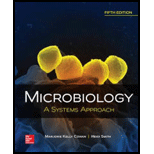
Microbiology: A Systems Approach
5th Edition
ISBN: 9781259706615
Author: Marjorie Kelly Cowan Professor
Publisher: McGraw-Hill Education
expand_more
expand_more
format_list_bulleted
Question
Chapter 3.2, Problem 5AYP
Summary Introduction
To convert:
Different lengths according to metric system.
Concept introduction:
The metric system is also called as the decimal system of measurement. Now it is known as the SI unit (International System of Unit) Scientists has adopted the metric system as the most common system of measurement of lengths and weights.
Expert Solution & Answer
Want to see the full answer?
Check out a sample textbook solution
Students have asked these similar questions
If the metabolic scenario stated with 100 mM of a sucrose solution, how much ATP would be made then during fermentation?
What is agricu
When using the concept of "a calorie in is equal to a calorie out" how important is the quality of the calories?
Chapter 3 Solutions
Microbiology: A Systems Approach
Ch. 3.1 - Explain what the Five Is mean and what each step...Ch. 3.1 - Discuss three physical states of media and when...Ch. 3.1 - Compare and contrast selective and differential...Ch. 3.1 - Provide brief definitions for defined and complex...Ch. 3.2 - Prob. 5AYPCh. 3.2 - Prob. 6AYPCh. 3.2 - Prob. 7AYPCh. 3.2 - Prob. 8AYPCh. 3.2 - Compare and contrast the three main categories of...Ch. 3 - Prob. 1MCQ
Ch. 3 - A mixed culture is a. the same as a contaminated...Ch. 3 - Resolution is ____ with a longer wavelength of...Ch. 3 - A real image is produced by the a. ocular. b....Ch. 3 - Prob. 5MCQCh. 3 - The specimen for an electron microscope is always...Ch. 3 - Prob. 7MCQCh. 3 - Bacteria tend to stain more readily with cationic...Ch. 3 - Multiple Matching. For each type of medium, select...Ch. 3 - A fastidious organism must be grown on what type...Ch. 3 - Agar has the disadvantage of being easily...Ch. 3 - A subculture is a culture made from an isolated...Ch. 3 - Prob. 13TFCh. 3 - Prob. 14TFCh. 3 - The best stain to use to visualize a microorganism...Ch. 3 - What is the functional type of mannitol salt agar...Ch. 3 - Create a short paragraph to differentiate among...Ch. 3 - Prob. 3CTQCh. 3 - a.Create a paragraph to differentiate among the...Ch. 3 - You are a scientist studying a marsh area...Ch. 3 - Visual Connections Blooms Level 5: Evaluate These...Ch. 3 - Prob. 1CM
Knowledge Booster
Similar questions
- What did the Cre-lox system used in the Kikuchi et al. 2010 heart regeneration experiment allow researchers to investigate? What was the purpose of the cmlc2 promoter? What is CreER and why was it used in this experiment? If constitutively active Cre was driven by the cmlc2 promoter, rather than an inducible CreER system, what color would you expect new cardiomyocytes in the regenerated area to be no matter what? Why?arrow_forwardWhat kind of organ size regulation is occurring when you graft multiple organs into a mouse and the graft weight stays the same?arrow_forwardWhat is the concept "calories consumed must equal calories burned" in regrads to nutrition?arrow_forward
- You intend to insert patched dominant negative DNA into the left half of the neural tube of a chick. 1) Which side of the neural tube would you put the positive electrode to ensure that the DNA ends up on the left side? 2) What would be the internal (within the embryo) control for this experiment? 3) How can you be sure that the electroporation method itself is not impacting the embryo? 4) What would you do to ensure that the electroporation is working? How can you tell?arrow_forwardDescribe a method to document the diffusion path and gradient of Sonic Hedgehog through the chicken embryo. If modifying the protein, what is one thing you have to consider in regards to maintaining the protein’s function?arrow_forwardThe following table is from Kumar et. al. Highly Selective Dopamine D3 Receptor (DR) Antagonists and Partial Agonists Based on Eticlopride and the D3R Crystal Structure: New Leads for Opioid Dependence Treatment. J. Med Chem 2016.arrow_forward
- The following figure is from Caterina et al. The capsaicin receptor: a heat activated ion channel in the pain pathway. Nature, 1997. Black boxes indicate capsaicin, white circles indicate resinferatoxin. You are a chef in a fancy new science-themed restaurant. You have a recipe that calls for 1 teaspoon of resinferatoxin, but you feel uncomfortable serving foods with "toxins" in them. How much capsaicin could you substitute instead?arrow_forwardWhat protein is necessary for packaging acetylcholine into synaptic vesicles?arrow_forward1. Match each vocabulary term to its best descriptor A. affinity B. efficacy C. inert D. mimic E. how drugs move through body F. how drugs bind Kd Bmax Agonist Antagonist Pharmacokinetics Pharmacodynamicsarrow_forward
- 50 mg dose of a drug is given orally to a patient. The bioavailability of the drug is 0.2. What is the volume of distribution of the drug if the plasma concentration is 1 mg/L? Be sure to provide units.arrow_forwardDetermine Kd and Bmax from the following Scatchard plot. Make sure to include units.arrow_forwardChoose a catecholamine neurotransmitter and describe/draw the components of the synapse important for its signaling including synthesis, packaging into vesicles, receptors, transporters/degradative enzymes. Describe 2 drugs that can act on this system.arrow_forward
arrow_back_ios
SEE MORE QUESTIONS
arrow_forward_ios
Recommended textbooks for you
 Nutrition Through The Life CycleHealth & NutritionISBN:9781337919333Author:Brown, Judith E.Publisher:Cengage Learning,
Nutrition Through The Life CycleHealth & NutritionISBN:9781337919333Author:Brown, Judith E.Publisher:Cengage Learning,





Nutrition Through The Life Cycle
Health & Nutrition
ISBN:9781337919333
Author:Brown, Judith E.
Publisher:Cengage Learning,